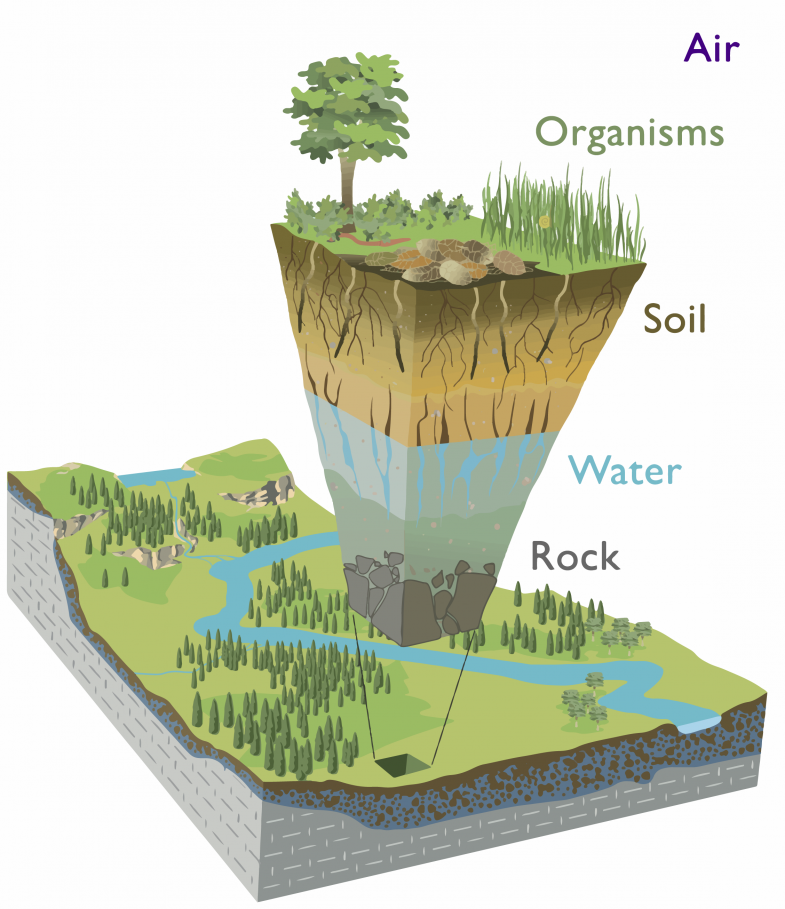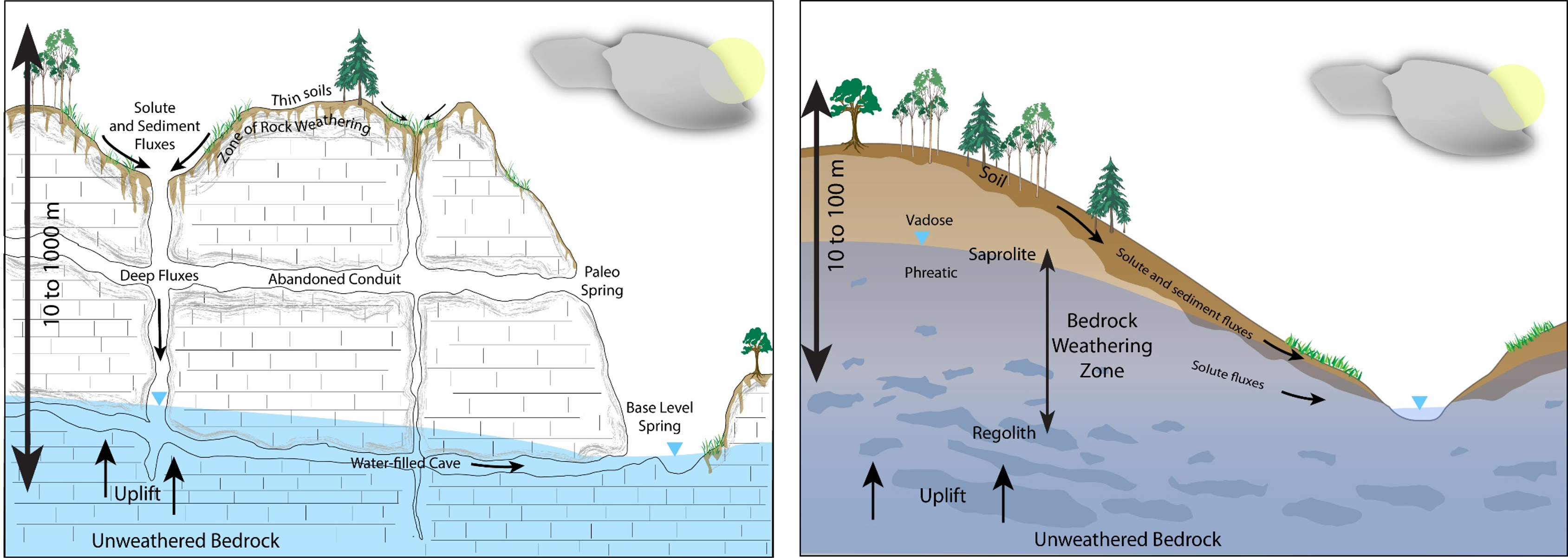Critical Zones:
The Earth’s Critical Zone, defined as the region from the tops of the trees to the bottom of the groundwater, provides life-sustaining resources including food production, water quality, and other ecosystem services. Over the last decade the National Science Foundation funded Critical Zone Observatory (CZO) network has transformed our understanding of how critical zone (CZ) processes regulate the production of these services. However, none of the CZOs within the network occur in landscapes underlain by carbonate bedrock (which cover about a quarter of Earth’s land surface), limiting the development of a holistic understanding of CZ processes.
Carbonate Critical Zone RCN Themes
Considering Earth’s critical zone as a gradient between predominately silicate to predominately carbonate minerals may aid understanding CZ process and characteristics. Because studies of the carbonate end member are limited, focused evaluations of carbonate-rich CZs could improve understanding of critical zone processes and characteristics and how they depend on the fractional amounts of the two mineral groups and their distributions - varying proportions within a single lithology or stratified horizontally or vertically. This RCN thus aims to assess how critical zone processes and characteristics vary depending on carbonate mineral composition by considering questions linked to various themes related to CZs of predominately carbonate minerals (see below).


Cartoons representing a silicate dominated CZ (right) and carbonate mineral CZ (left).
Carbonate Critical Zones Themes
Architecture
Increased fractions of carbonate minerals increase the extent of congruent dissolution of critical zone minerals. Carbonate-dominated critical zones will display classic karst features, such as caves and sinkholes. Variations in architecture should affect transport of solutes through and export of solutes from critical zones.
Questions to consider:
- How does the relative amount of congruent versus incongruent dissolution alter critical zone architectures and processes?
Climate and land use change
Antropogenic disturbances of critical zones include local impacts, for example from changing land use and infrastructure development, to global changes including expectations of rising temperatures and increased extreme weather events from climate change.
Questions to consider:
- What critical processes will be altered, and by what extent, as climate changes over the next decades?
- How will varying reaction rates of silicate and carbonate minerals respond to changing climate including global warming and shifts in precipitation patterns?
- What land use changes will bring the greatest changes to critical zone processes?
Ecology
Macro- and micro-biotic processes produce and consume CO2, which is the principal, but not only, weathering agent in critical zones. Biotic processes also alter other acid production and redox conditions. Thus the depth within and distribution across critical zones of biological processes are important for dissolution reactions.
Questions to consider:
- How do interactions between biota and critical zone structure vary along lithological gradients?
- What processes control terrestrial vegetation and soil microbial community composition and structure?
- How does variation in biotic communities affect bio-reactive solute and gas fluxes, and bedrock dissolution through and from critical zones?
- How do the fluxes feedback to controls on the biotic processes?
- How do downstream aquatic communities respond to different geomorphic, hydrologic, and hydrochemical regimes along such lithological gradients?
Hydrology
The extent and distribution of congruent dissolution will alter water flow paths and rates through the critical zone. The flow rates, and distribution of flow paths, should alter water-rock interactions and dissolution. They should also alter exchange of water and gases between the land surface and subsurface.
Questions to consider:
- What impacts result from feedbacks between congruent dissolution, formation of preferential flow paths, and water delivery to and through the critical zone?
- How do water and solute flow paths, fluxes, and travel time distributions vary with the proportion of silicate and carbonate materials in the critical zone?
Ecosystem goods and services
Karst critical zones provide important ecosystem goods and services, including water supply (for domestic, agricultural, industrial, recreational and ecosystem uses), food security, habitats for endangered species, and carbon sequestration. Climate change, sea level rise, human water use, and point and non-point source pollution from urban, industrial and agricultural sources all threaten the provision of these services.
Questions to consider:
- What are these services and how do they vary across lithological gradients?
- What are the implications of changes in weathering, biogeochemical cycling and partitioning of hydrologic fluxes to the provision of these services?
- How does the provision of, and threats to, these services vary with the proportion of silicate and carbonate materials in the critical zone?
Time
Critical zone processes range across time scales from event (floods, fires, droughts) to intermediate (community assemblage and succession; responses to disturbance) to geologic (biological evolution, geomorphic changes). These distinct time scales and the rates of each process, dictate how critical zone characteristics will respond to the processes.
Questions to consider:
- How do rates of critical zone processes scale with varying amounts of carbonate and silicate contents of the critical zone?
- How do the varying time scales of processes interact;for example, how would increased fire rates alter community assemblages and succession?
Weathering
Weathering of critical zone minerals depends on the delivery rates of acids, local redox conditions, and variations in the dissolution rates for each mineral weathering reaction. Amount and rates of weathering control solute and some nutrient production, alterations of mineralogical composition, and thus physicochemical characteristics of the critical zone.
Questions to consider:
- What are relative contributions of various acids to weathering in critical zones (e.g., carbonic, sulfuric, nitric, organic)?
- How do reaction mechanisms of each affect solute and gas cycling within the critical zone?
- How will contributions from each acid change in the future, for example, through addition of pollutants and acid rain?
- How do redox conditions vary across space and time in critical zones and what controls the variations?
